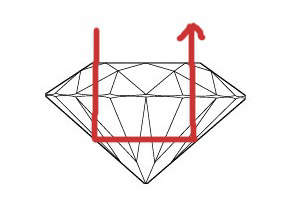The cut of a diamond is probably the most important ofthe 4 C’s. It is also the only one of the 4c’s that can be influenced by man. The other 3c’s, color, clarity and carat are determined by nature.
The cut of the diamond gives it its brilliance and fire. The best cut allows the maximum amount of light to enter and be reflected back out of the diamond.


The figures above and below illustrate the diamond proportions and facets of a round brilliant cut.

Do not confuse!
One should not confuse ‘diamond cut’ with ‘diamond shape’.
The cut of a diamond refers to how well the cutting had been executed, or in other words, in reference to the diamonds reflective properties.
The shape of a diamond is the general outward appearance of a diamond eg. pear, round and emerald. That is the diamonds can be cut in various shapes.
However cut can also be used to refer to shape eg pear cut etc.
Fire and Brilliance
Both the ‘fire’ and ‘brilliance’ of a diamond is affected by the cut of a diamond.
The ‘fire’ of a diamond refers to the lovely rainbow colours that flash from within, while the brilliance refers to the liveliness and sparkle.
An Ideal Cut and Poorly Cut Diamond
The ideal cut allows the maximum amount of light to enter and be reflected back out of the diamond.
In a poorly cut diamond, the light which enters through the table reaches the facets and leaks out from the bottom or the sides of the diamond instead of reflecting back to the eye. The more the light reflected back the more the briliance and vice versa.

The figure above is illustrating the reflection of light in an ideal cut diamond

Reflection of light in a shallow cut diamond

Reflection of light in a deep cut diamond
For the purpose of discussion of this topic on this page, we will be referring to the modern round brilliant cut which has 58 facets (with the culet) or 57 facets without the culet. The modern round brilliant cut also accounts for 75% of all cut diamonds.
Optimal Proportion
It is quite difficult for a casual or non-professional observer to notice the difference in proportion between an ideal cut and poorly cut diamond. Therefore it is wise to ask for a diamond certificate from a reliable/reputed gemological laboratory.
Ideal diamond cuts can also be measured by certain parameters such as:
i) Percentage of the Table: 57-64%
ii) Dept percentage : 60-63%
iii) Girdle: Very thick to thin, faceted
iv) Culet: Either pointed or none.
v) Polish: Very good to fair
vi) Symmetry: Very good to fair.
who decides the cut of a diamond?
A rough diamond crystal is cut by a diamond cutter. The diamond cutter has to make the choice weather he will cut a proportionate brilliant stone or the largest diamond he can from the rough diamond. Therefore the brilliant diamond becomes smaller but it is still valuable because of its brilliance.If the diamond is cut to make a larger stone by sacrificing its brilliance, it will be less valuable per crat than the brilliant stone.
Grading of Diamond Cut
The cut of a diamond may be graded as follows:
i) Ideal:Maximizes brilliance ofthe stone. The table is also smaller creating more dispersion and fire.
ii) Premium:These diamonds are cut with the intention of producing the maximum brilliance and fire.
iii)Very Good:These diamonds reflects most of the light that enters them.
iv)Good:Reflects a large percentage of light that enters it.
v)Fair & Poor:These reflect only a small proportion of light that enters it.
My Recommendation
I always recommend that one should buy an Ideal Cut Diamond, because it will have a brilliance that will last forever. It would also be good for investment purposes.You are welcome to discuss this post/related topics with Dr Shihaan and other experts from around the world in our FORUMS (forums.internetstones.com)
References;
